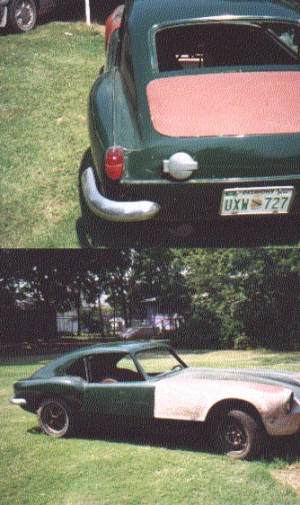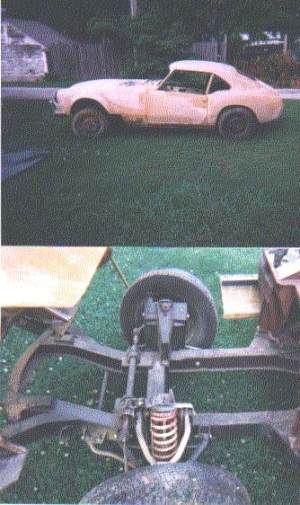�
 �
�
 �
�
Roger Young's Triumph GT6, with Chevy V6
��
(as recorded by Dan Masters)
�
Roger wrote:
�
�
I contracted British Car Fever many years ago from a 1970 Lotus Elan +2. �
Owning and driving a Lotus is like being in love with an evil woman.�
The Lotus was cranky, picky, unreliable, she demanded constant attention�
and always let me down at the worst possible time. She sucked my bank account�
dry and left me stranded time and again. But, when the Lotus was good; she�
was SOOOOOO good. Her exhaust thundered, widows rattled as we passed by,�
the ground shook and the mortals quivered in terror as we exploded past them.�
Of course, such affairs never last and after 10 years of ownership and 18�
months of actual service we parted company.
�
�
It took several years for the pain of that relationship to�
heal. It took a couple more years for the bank account to recover. Then�
I decided to - DO IT ALL AGAIN. This time will be different; this time I'll�
build my own; a car with all the Lotus ground pounding thunder and none of�
the bad stuff. The Triumph Spitfire/GT6 looked like the best starting place.�
The Spit is light, the body proportions are good, I love the clam shell�
bonnet; it's a good, simple design. All that's needed is to fix the engine,�
transmission, electrical, hydraulic and rear suspension problems, in other�
word - throw them away and splice in the appropriate American components.
�
�
I found my GT6 (her name is Lola) in 1996 on the back row of a seedy used car lot. �
She was painted school bus yellow, had a stripped differential and no half shafts. �
Her body was fairly straight; she showed no signs of rust, and had 83,000 miles �
on her odometer. The dealer wanted $500 for her and urged me to act now because �
he had another buyer coming in to pick up the car in a day or two. I told him �
she was only worth $300 to me. A week later I towed Lola home - for $300. �
My journey started with the decision to flare the rear fenders, from there things �
got a little out of hand.�
�
Here is a list of the body modification made to date:
�
- �
- Rear fenders have been flared 4" per side (inspired by the AC Cobra) �
- Front fenders have been flared 2 1/2 inches per side (inspired by the AC Cobra) �
- License plate recess has been cut out and replace with a smooth panel (inspired by the '58 Vette) �
- Hatchback was welded down and a proper boot lid fabricated (inspired by the '59 Ferrari 250 GT. Hatchbacks are for Pintos!) �
- Roof rain channels were welded and trimmed smooth (just because) �
- Rear quarter panel window were recontoured to match the roof line (they looked goofy) �
- Frame and bonnet have been stretched 7" (improves the overall proportions of the car and allows easy installation of a V8) �
- Bonnet nose has been rounded (inspired by the Ferrari 275 GTB - everything else on Lola is roundy and curvy) �
- Hood bulge has been raised and extended back the full length of the bonnet (inspired by the '70 Chevelle - carb clearance and cold air intake) �
- Front bumper has been split (inspired by the Ferrari 275 GTB - my bumper was bent in the middle) �
- Windshield frame has been welded-in permanently and filled (just because) �
�
� Lola currently has an Opel GT rear axle. The Opel axle was� the right width, has a good basic design and is strong enough to handle a� V6 engine. Installing it required extensive frame and floor pan modifications.� I'm not unhappy with the Opel axle, but in retrospect it would have been� easier to fabricate a new frame and use a Datsun 240Z rear end.
�
� The frame stretch left room for a V8, but I think a high winding� V6 better matches the car's character. I used a Chevy 2.8L V6 engine from� a Citation and mated it to a 5-speed transmission from a Chevy S10. Installation� required trimming the frame to clear the starter and minor frame modifications� around the transmission. Cooling is handled by an '84 Camaro radiator, it� mounted vertically with half inch of hood clearance. My choice of engine/transmission� combination was based primarily on what I had lying around.
�
� I had constant problems with the hydraulic and electrical� systems on my Lotus and I was determine to eliminate everything Lucas and� Girling from the Triumph. I found Datsun components to replace the brake� master cylinder, clutch master cylinder and clutch slave cylinder. The Japanese� obviously copied Girling designs, the Datsun parts look similar to their� Girling counterparts and the bore and stroke dimensions are identical. The� brake and clutch master cylinders bolted in after I elongated the flange� boltholes with a file. The clutch slave cylinder required and adapter plate� to bolt up. Hood clearance demanded that I build new fluid reservoirs, with� I made using PVC pipe fittings. The rear brakes are Opel and I'm still working� on the front disk brake solution.
�
� To cure the electrical problems I adapted Ford light sockets� into the Triumph light housings and I replaced all the dash switches with� industrial grade toggle switches. The switches are rated for 30 amps and� eliminate the need for relays. I fabricated a simplified wiring harness� using a '57 Ford wiring diagram as a guide. I replaced the three-piece� wooden dash with a single oak panel. The oak does not splinter when sawing� or drilling out the gauge holes; I found it much easier to work than plywood.
�
� The car is starting to come together relatively quickly now,� in retrospect I did a lot of things right and I did a lot of things wrong.
�
� Stretching the wheelbase turned out to be very right. I know several� people have stuffed V6 engines into the stock Spit - but I don't see how.� The added length improve the cars proportions, the engine just fell in,� it cured the exhaust system problem (side pipes) and improved the weight� distribution.�
� �
�
I should have stretched the rear fender flares out 5 inches per side - even�
with a 4 inch flare the wheel wells are a little tight. I could not have taken�
the front flares out any further - any more would have looked odd.
�
�
My original decision to make all the body modifications in steel turned�
out to be a mistake. I know some people have the skill to fabricate body�
panels in steel - but I'm not one of those people. The flanged body panels�
Triumph uses actually lends it self to using glass panels. I believe the�
body substructure will provide adequate support for the glass panels. I�
wasted a lot of time and effort.
�
�
Keeping the original frame was a mistake. The stock frame is stamped�
10-gauge sheet metal and the factory welding is hideous. I have a new frame�
on the drawing board. The new frame is fabricated of 3 inch channel iron and�
is substantially stronger than the stock unit. Using the channel allows�
an additional 3 inches of width for the engine/transmission. The basic layout is�
essentially a copy of the original central backbone fame, but my new design�
incorporates doorsill outriggers resulting in a combination perimeter/central�
backbone chassis. This increases body stiffness and allows the floorboards�
to be incorporated into the frame. I hope to use a stock Datsun differential�
and rear suspension. Using the Datsun rear end will increase the rear track�
width (the stretched fender should allow it) and will require widening the�
front track to match. I will eventually install this frame in my car.
�
�
Using the little Chevy engine was a good choice. Installing it was�
actually the easiest part of the process. Lola is technically a mid-engine�
car with her engine mounted just behind the centerline of the front axle.�
The stock air cleaner fits with a half inch left to spare and I believe the steering�
column is going to just sneak by the exhaust manifold. Piecing together�
the engine and transmission was a definite mistake. I've got adapter plates�
to mount the starter to the engine, I've got the GT6 shifter mounted to the�
Chevy transmission, custom bent tubes to route the water to the radiator,�
the list goes on and on. Just strip everything from a Camaro and be done�
with it. The Camaro engine comes with (or will accept) a single wire distributor�
with integral coil, single wire alternator, a 2 barrel Rochester carb, and�
the shift knob location is close to the stock Triumph location. I've also�
discovered the Camaro air conditioning compressor tucks in neatly above the�
intake manifold with adequate hood clearance.
�
�
I am currently doing the final fitting and finish sanding on the body�
panels. I moved the battery to the boot, leaving space on the firewall to�
install an A/C unit. The exhaust system plumbing is the last major project.�
With luck, Lola should see the road this year.
�
�
p.s. I get odd reactions from people when I describe my little British car. �
My wife, co-workers, friends and family are unable to decide whether I'm: �
(a) simply stupid (b) slightly insane or (c) both.�

